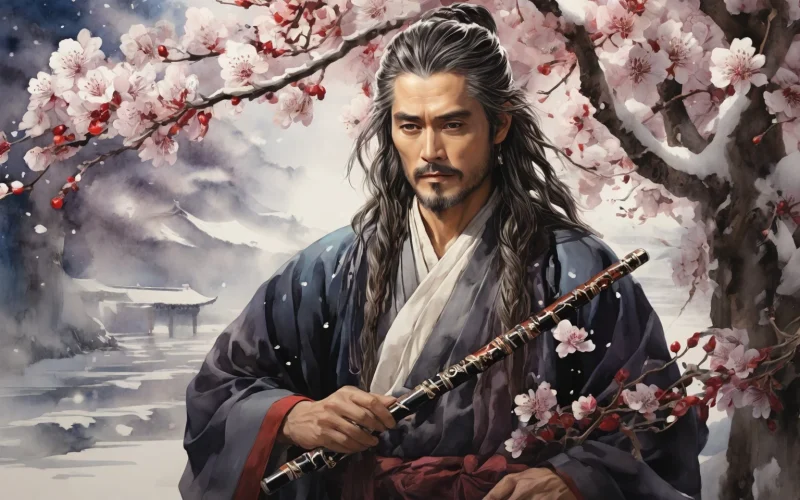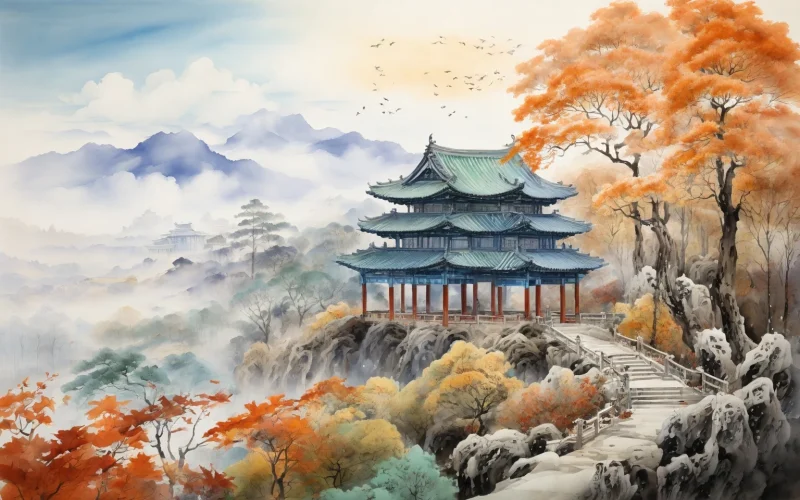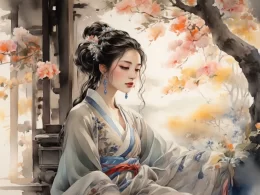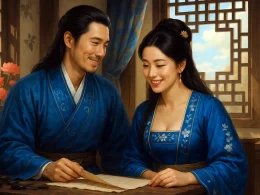The flute played on "Mume Blossoms" on Northern Frontier,
"The Laurel Branch" to Southern River shore was dear.
They were sung in the former dynasties for long.
Now listen to my newly composed "Willow Song".
Original Poem:
「杨柳枝词九首 · 其一」
刘禹锡
塞北梅花羌笛吹,淮南桂树小山词。
请君莫奏前朝曲,听唱新翻杨柳枝。
Interpretation:
"杨柳枝词" is one of the works Liu Yuxi composed later in life in response to Bai Juyi’s poetry, part of a set of nine poems. This first poem marks a shift in Liu Yuxi’s literary creativity. By drawing upon the classical yuefu (folk song) traditions, especially works like "梅花落" and "招隐士," Liu Yuxi expresses his innovative literary concepts, emphasizing creation over mere imitation. This poem, connected to Bai Juyi's "杨柳枝," demonstrates the interaction between the two great literary figures and their shared spirit of literary innovation.
First Couplet: “塞北梅花羌笛吹,淮南桂树小山词。”
(In the north of the frontier, the melody of plum blossoms is played on the Qiang flute, while the song of the osmanthus tree in the south of the Huai River is written by Little Mountain.)
The first couplet uses the imagery of the plum blossom and the osmanthus tree to represent two distinct musical traditions. "梅花落" and "招隐士" are references to the musical cultures of the northern frontier and the Huai River south, respectively. These symbolic songs evoke the rich heritage of traditional culture.
Second Couplet: “请君莫奏前朝曲,听唱新翻杨柳枝。”
(Please do not play the old songs of the previous dynasty, but listen to my new rendition of "杨柳枝.")
The second couplet expresses the poet's desire to transcend tradition and embrace innovation. Liu Yuxi urges that the ancient songs should no longer be played, and instead, new artistic creations should be embraced, symbolizing his pursuit of modernity in the arts.
Writing Features:
- Traditional Reference, Creative Innovation:
By referencing traditional songs like "梅花落" and "招隐士," the poet positions himself within the classical tradition while advocating for the creation of something new, signaling his commitment to artistic renewal. - Elegant Parallelism and Concise Language:
The poem features balanced couplets and crisp language, showcasing the poet’s high artistic skills. Each line builds upon the previous one, achieving both unity in thought and form. - Contrast Between Old and New, Spirit of Innovation:
Through the rejection of traditional melodies, Liu Yuxi emphasizes his commitment to literary innovation. The poem captures the tension between tradition and novelty, reflecting the poet’s progressive mindset.
Overall Appreciation:
This poem reflects Liu Yuxi’s profound reflection on tradition and innovation. While invoking the ancient yuefu tradition through the references to the northern plum song and the southern osmanthus song, the poet makes a clear statement about the need for change in modern artistic creation. Through his collaboration with Bai Juyi, Liu Yuxi demonstrates his unwavering belief in literary innovation. This poem is not just a melodious, elegantly structured yuefu poem but also a manifesto for the principles of literary creation, exemplifying his spirit of breaking from the old and embracing the new.
Insights:
This poem conveys the deep idea that literary creation must be bold in innovation and not bound by tradition. Liu Yuxi’s work reminds us that, in both literary creation and other fields, it is only by breaking free from old constraints and pushing for change that greater development and success can be achieved. His line "请君莫奏前朝曲,听唱新翻杨柳枝" serves as both encouragement for creative endeavors and a call to anyone pursuing innovation and progress, inspiring people to embrace change and strive for new heights.
Poem translator:
Xu Yuan-chong (许渊冲)
About the poet:

Liu Yuxi(刘禹锡), 772 - 842 AD, was a native of Hebei. He was a progressive statesman and thinker in the middle of the Tang Dynasty, and a poet with unique achievements in this period. In his compositions, there is no lack of poems reflecting current affairs and the plight of the people.











